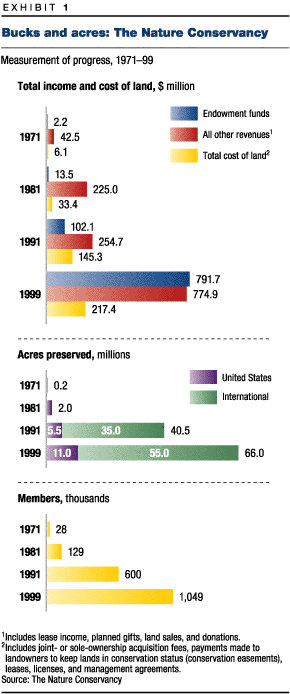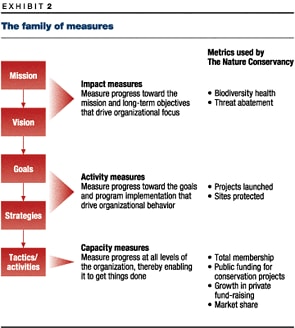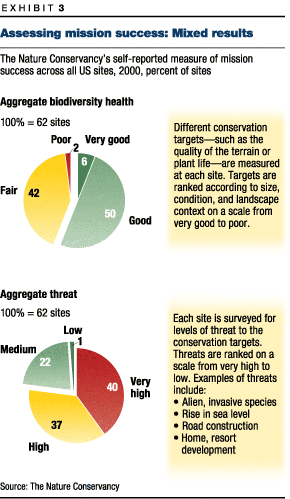Most nonprofit groups track their performance by metrics such as dollars raised, membership growth, number of visitors, people served, and overhead costs. These metrics are certainly important, but they don’t measure the real success of an organization in achieving its mission.
Of course, nonprofit missions are notoriously lofty and vague. The American Museum of Natural History, for example, is dedicated to “discovering, interpreting, and disseminating—through scientific research and education—knowledge about human cultures, the natural world, and the universe.” But though the museum carefully counts its visitors, it doesn’t try to measure its success in discovering or interpreting knowledge. How could it? The pace of scientific discovery hardly depends on the activities of a museum—even one as prominent as this. Similarly, CARE USA exists “to affirm the dignity and worth of individuals and families living in some of the world’s poorest communities.” Try to measure that.
Our research on 20 leading nonprofit organizations in the United States—as well as our firsthand experience with one of them, The Nature Conservancy—shows that this problem is not as intractable as it may seem. Although nonprofits will never resemble businesses that can measure their success in purely economic terms, we have found several pragmatic approaches to quantifying success, even for nonprofit groups with highly ambitious and abstract goals. The exact metrics differ from organization to organization, but this thorny problem can be attacked systematically.
To grasp the complexity of the task—and the serious problems of the approach that most nonprofits currently use—consider the experience of The Nature Conservancy.
Bucks and acres
For 50 years, the Conservancy has had a clear mission: to preserve the diversity of plants and animals by protecting the habitats of rare species around the world. For most of the history of this organization, it measured success solely by the second, more tangible, part of its mission: protecting habitats. Thus it would simply add up the amount of the annual charitable donations it received and the number of acres it was protecting. These metrics soon became enshrined as “bucks and acres.”
As a measurement system, bucks and acres had a lot going for it. Managers clearly understood how their programs would be judged and could act accordingly. The board of governors liked the emphasis on buying land—an approach that set the Conservancy apart from other environmental organizations: donors responded well to the clarity and simplicity of dollars raised and land saved.
These metrics told a tale of success (Exhibit 1). The Conservancy—the world’s largest private conservation group—has protected 12 million acres in the United States and millions of additional acres in 28 other countries. Last year, its membership climbed to 1.1 million people and its revenue to $780 million. Without question, the upward trajectory of these statistics bolstered the morale of the staff, increased its motivation, and inspired confidence among donors.

Despite this apparent success, in the early 1990s Conservancy managers began to realize that bucks and acres didn’t adequately measure the progress of the organization toward achieving its mission. The Conservancy’s goal, after all, isn’t to buy land or raise money; it is to preserve the diversity of life on Earth. By that standard, the Conservancy had been falling short every year of its existence. It had its successes, but the extinction of species continued to spiral out of control: one Harvard biologist, E. O. Wilson, estimates that the extinction rate today is as high as it was during the great extinction that wiped out the dinosaurs 65 million years ago.
What particularly worried the Conservancy was the fact that species were declining even within its protected areas. For instance, several years after acquiring property around Schenob Brook, in Massachusetts, specifically to protect the remaining bog turtles, the population started to shrink. It turned out that activities outside the preserve were affecting the water on which the turtles depended. In response, the Conservancy revisited its basic strategy. Instead of acquiring and protecting small parcels of land that harbor rare species—a Noah’s Ark strategy—the organization began to work on preserving larger ecosystems. This approach might mean looking outside the preserve, at conditions such as economic development, pollution, and soil erosion. It might also mean restoring an area’s natural environmental dynamics by once again allowing wildfires or floods to do their work. Not surprisingly, the old “acres-protected” measure did little to clarify the effectiveness of the new conservation strategy.
It soon became clear that the “bucks” measure—biased as it was toward raising money for projects that appealed to donors but didn’t necessarily advance the organization’s mission—also left much to be desired. The Conservancy has always maintained that it is in the science business, not the beautification business; protected areas must be chosen for their scientific value, not for their scenic qualities or proximity to major population centers.
In 1996, the Conservancy decided to abandon bucks and acres and to develop a better way of measuring success.
A new framework
After spending several years trying out different approaches—including one that involved 98 different metrics—the Conservancy settled on a simple framework for measuring performance. Known as the “family of measures” (Exhibit 2), it can be used by any nonprofit organization (see sidebar, “Link your metrics to your mission”).

Every organization, no matter what its mission or scope, needs three kinds of performance metrics—to measure its success in mobilizing its resources, its staff’s effectiveness on the job, and its progress in fulfilling its mission. The specific metrics that each nonprofit group adopts to assess its performance in these categories will differ; an environmental organization might rate the performance of its staff by whether clean-air or -water legislation was adopted, a museum by counting how many people visited an exhibition. But any comprehensive performance-management system must include all three types of metrics. Financial metrics, such as the percentage of revenue spent on overhead and administration, are also important management tools, but since the law requires organizations to report them, they are excluded from this framework.
Two of the three necessary types of metrics are relatively easy to create: those that measure the mobilization of resources and those that track the activities of the staff. Indeed, these two sets of metrics are actually similar to The Nature Conservancy’s old bucks-and-acres system, and most nonprofit organizations already have a version of them. Metrics for the mobilization of a group’s resources could include fund-raising performance, membership growth, and market share; metrics for staff performance, the number of people served by a particular program and the number of projects that an organization completes.
The third kind of metric—measuring the success of an organization in achieving its mission—is considerably more difficult to create, but, as The Nature Conservancy discovered, it is also the most crucial.
Measuring the success of the mission
Our research has found that nonprofit organizations, despite the enormous difficulties, can measure their success in achieving their mission. They have three options. First, a nonprofit group can narrowly define its mission so that progress can be measured directly. The mission of Goodwill Industries, for example, is to raise people out of poverty through work: “A hand up, not a hand out.” Goodwill can therefore measure its success simply by counting the number of people participating in its training programs and then placed in jobs. Its affiliates offer many programs besides those for job training, but all are linked to the core purpose of providing the poor with employment. By contrast, Catholic Charities and World Vision, though comparable organizations, have broader antipoverty missions that are impossible to quantify directly.
Nonprofit groups that take the option of defining their mission narrowly must avoid the trap of oversimplifying it and treating the symptoms rather than the cause of a particular social problem. Until recently, the mission of the US charity America’s Second Harvest was to feed the hungry, and it could easily quantify its success by counting the amount of food it collected and distributed. The organization’s leaders have since decided to expand their activities to address the underlying problem and have therefore adopted a more ambitious mission: ending hunger in the United States. Advocacy and public-education efforts have become a larger part of the charity’s agenda, and the organization’s success will be judged not only by statistics on hunger but also by changes in public attitudes as expressed in opinion surveys.
A second option for measuring the success of an organization in achieving its mission is to invest in research to determine whether its activities actually do help to mitigate the problems or to promote the benefits that the mission involves. The nonprofit organization Jump$tart Coalition, dedicated to improving the educational outcomes of poor children, is a good example of this approach. One of the biggest challenges facing the federal education program Head Start is that many children leave it, at age five, still unprepared for school. Jump$tart developed a program to help Head Start’s lowest achievers, at age four, improve their basic literacy skills. Statistical studies, updated periodically, have clearly shown that Jump$tart graduates enter kindergarten better prepared than do similar children who didn’t participate in the program and, more important, that its graduates have better educational outcomes throughout primary school. With the link between the organization’s program and mission firmly established, Jump$tart can now measure its success by the number of children in its programs.
Nonprofit organizations with less quantifiable missions will find this approach more difficult. The mission of the Girl Scouts of the USA, for instance, is to help young girls reach their full potential as citizens. The Girl Scouts commissioned a large-scale study concluding that its members do indeed become more successful, responsible citizens than do women who hadn’t been Scouts.1 The study got around the problem of defining the term “responsible citizens” by using proxies such as professional success, divorce rates, and participation in civic life (for instance, voting), as well as self-reported measures of happiness and satisfaction. It did not, however, control for the problem of selection bias: girls who signed up for the Girl Scouts might have become more successful citizens even if they hadn’t done so, because of their personal characteristics or family background. Nonetheless, the organization does have evidence, albeit fuzzy, that its programs work. It now measures its success in achieving its mission by counting the number of children (particularly from historically underrepresented demographic and socioeconomic groups) in its programs.
For most nonprofit organizations, however, narrowing the scope of the mission isn’t an option and investing in research into outcomes isn’t feasible. The Nature Conservancy, for example, could conceivably calculate changes in the Earth’s total biodiversity, but the benefits of that approach wouldn’t justify the astronomical cost of doing so. The Conservancy’s work has at best only a modest—if not imperceptible—effect on global biodiversity, which is affected on a far greater scale by other factors, such as tropical deforestation, climate change, and the conversion of habitats.
These nonprofits have a third option for measuring their success in achieving their mission: they can develop microlevel goals that, if achieved, would imply success on a grander scale. The Nature Conservancy can’t measure global biodiversity, but it can closely examine biodiversity in the areas it manages. So it has chosen to determine its success in achieving its mission by gauging the success of its biodiversity health and threat-abatement efforts in the areas it protects. Both are relatively easy to measure: to measure the success of the biodiversity-health effort, the Conservancy evaluates the condition of all the plants and animals it is trying to save against a baseline set of data established by existing scientific surveys; to measure the success of its efforts to control threats to biodiversity, the Conservancy tracks its programs to counter the most critical threats to environmental health in particular places (Exhibit 3). If the organization meets these two goals in all its project areas, it will ultimately have a lasting, positive impact on biodiversity.

One of the benefits of this approach is that microlevel goals can be simple and clear. The mission of the Chesapeake Bay Foundation (CBF) is to preserve the health of the Chesapeake estuary. In 1995, CBF worked out nine indicators of the bay’s health, such as water clarity, levels of dissolved oxygen, migratory fish populations, and the size of the surrounding wetlands. It collected baseline data for each indicator and then set specific ten-year targets representing significant progress for the bay. The power of this approach lies in its simplicity: government agencies already collect information about the nine indicators, at no cost in time or money to CBF. The general public and potential donors easily understand the indicators: adding 125,000 acres of wetlands to the bay’s watershed by 2005 is quite clear. CBF’s president holds an annual press conference to issue a report card on the bay’s health, thus increasing public awareness and mobilizing support. If CBF reaches its goal for each of the nine indicators, it will have met its broader objective of preserving the health of the bay.
What about organizations with more ambiguous and ambitious social goals? Preventing cancer and reducing the anguish and deaths from it are far more difficult tasks. How can the American Cancer Society (ACS) distinguish between its impact and the effect of the many other variables that influence cancer rates? The management of ACS reasoned that it doesn’t matter who deserves credit for any decline in cancer rates. What does matter is that ACS should use its own resources in the most effective possible way. It has thus set specific goals: reducing cancer mortality rates by 50 percent and the overall incidence of cancer by 25 percent as of 2015. Because empirical research shows that prevention, screening, and educational programs are highly effective in reducing both the incidence of and mortality from cancer, ACS has moved away from research and toward prevention and awareness programs.
With creativity and perseverance, nonprofit organizations can measure their success in achieving their mission—by defining the mission to make it quantifiable, by investing in research to show that specific methods work, or by developing concrete microlevel goals that imply success on a larger scale.
Given the diversity of the organizations in the nonprofit sector, no single measure of success and no generic set of indicators will work for all of them. Nonetheless, our experience and research indicate that these organizations can—indeed, must—measure their performance and track their progress toward achieving their mission. They owe their clients, their donors, and society at large nothing less.